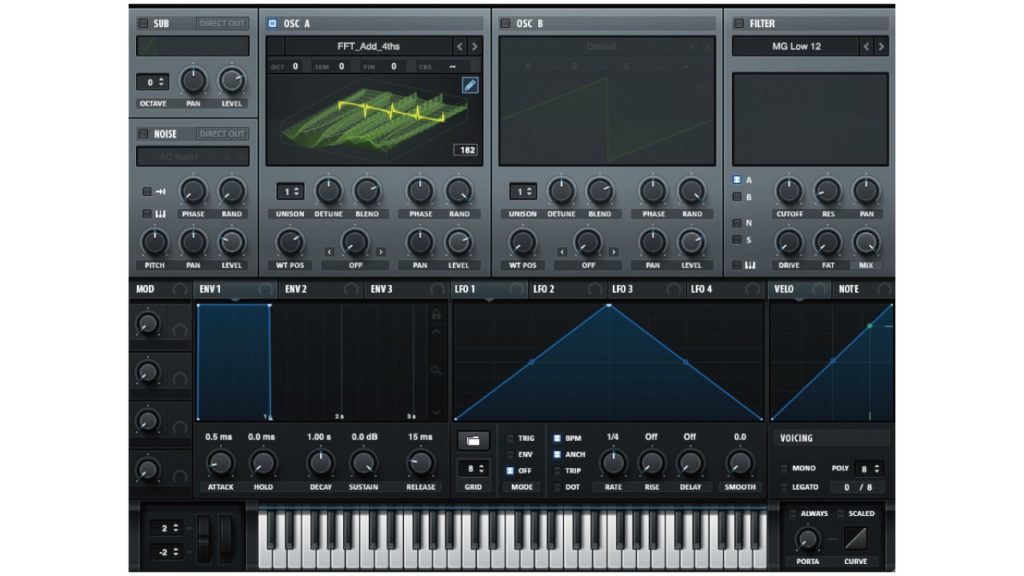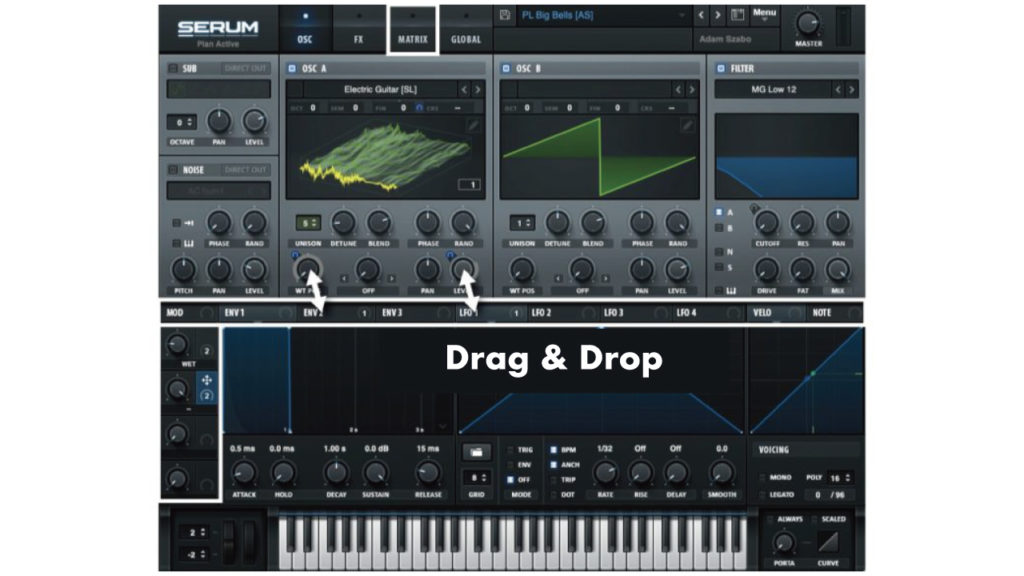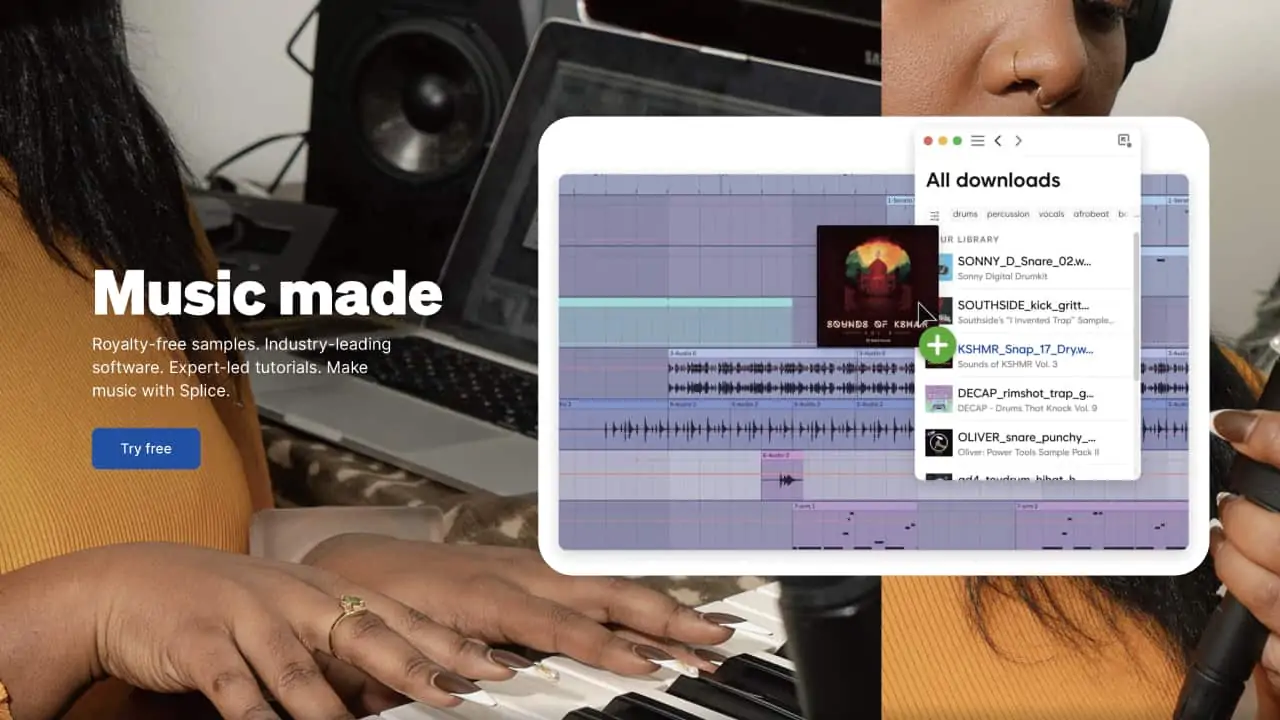Probably the most popular soft synthesizer is Xfer Records “SERUM”.
I will review why Xfer Records “SERUM” is so popular. In addition, I also explain how to use it, so please refer to it.
1. What is Xfer Records “SERUM” ?
https://www.youtube.com/watch?v=BDB-_ogLufI&feature=emb_title
SERUM is a wavetable type synthesizer software developed by Xfer Records.
Especially attractive is the oscillator. You can create an oscillator.
Xfer Records SERUM ▶︎Plugin Boutique
▶︎Plugin Boutique
What is a wavetable synthesizer?
First wavetable synthesizer “PPG WAVE”
A method that creates sounds by synthesizing sample data or waveforms. Unlike analog synthesizers, it features a wide variety of oscillators. SERUM allows you to capture your own audio as an oscillator.
SERUM is also available as a monthly payment with Splice Plugins. Click here for articles about Splice Plugins.
2. Advantages
There are three advantages when using Xfer Records “SERUM”.
- An oscillator that can create a wide range of sounds
- Easy-to-understand GUI
- The effect is also attractive
(1)An oscillator that can create a wide range of sounds

Unlike ordinary analog synthesizers, there are many types of oscillators. By default, there are 42 types of Analog, 56 types of Digital, 35 types of Spectral, and 11 types of Vowel.
You can also capture your own audio or edit the waveform to create a new oscillator.
(2)Easy-to-understand GUI

It is a specification that makes it easy to see what changed when you tamper with the parameters, making it easy for synthesizer beginners.
(3)The effect is also attractive

There are 10 types of effects: HYPER / DIMENSION, DISTORTION, FLANGER, PHASER, DELAY, CHORUS, COMPRESSOR, REVERB, EQ and FILTER.
There aren’t many, but I felt that CHORUS and PHASER are very compatible with the sound of SERUM.
3. Disadvantages that you should know before using
However, there is two disadvantages to know before using Xfer Records “SERUM“.
- Since it is a digital cold sound, there are some genres that do not fit
- No discount
(1)Since it is a digital cold sound, there are some genres that do not fit

Since it is a wavetable synthesizer, it basically produces a digital sound. SERUM is often used in EDM, but I think there are some genres that don’t fit.
If you want to have a complete set of software synthesizers, I recommend that you have SERUM as a digital synthesizer, and separately obtain vintage synthesizer emulation software (analog synthesizer, etc.)
(2)No discount
SERUM offers almost no discount compared to other synthesizer software.
However, it is recommended that you can use SERUM with Splice Plugins for a monthly payment.
4. Presets
There are many SERUM presets at Plugin Boutique, and there is also an Expanded Bundle that includes 1300 presets, and 500 MIDI files.
Xfer Records SERUM + Presets ▶︎Plugin Boutique
▶︎Plugin Boutique
You can also get presets from the monthly sample service Splice Sounds.
How to add presets

Select “Show Serum Presets Folder” from the upper right MENU.
Put the fxp file in the Presets folder and you’re done.
5. How to install and activate Xfer Records products
Installation and activation methods are explained in Plugin Boutique.
It is mainly completed in the following 2 steps.
- Account registration, product registration, download at Xfer Records
- Enter the activation code when launching the software on your DAW
6. How to use

- OSC
- FILTER
- VOCING & PORTAMENT
- MATRIX
- ENVELOPES
- LFO
- MOD、MACRO
- FX
(1)OSC
SERUM uses two oscillators, a sub oscillator, and noise as the basis for sound creation. Each can be turned on and off with the blue button on the upper left.
OSC A/B

Select from 42 types of Analog, 56 types of Digital, 35 types of Spectral, and 11 types of Vowel.
You can display the three-dimensional waveform and the planar waveform by clicking the screen.

OCT, SEM, FIN and CRS on the top change the pitch respectively.
OCT (Octave) : Octave change, -4 to 4
SEM (Semi) : Change by semitone, -12 to 12
FIN (Fine) : 100 to change the semitone, -100 to 100
CRS (Coarse Pitch) : 1.00 semitone change, -64.00 ~ 64.00
CRS can change the pitch most smoothly.

UNISON, DETUNE and BLEND below the waveform are all parameters that control the unison. The detailed settings for the unison sound are on another screen in GLOBAL above.
UNISON : You can increase the Unison up to 16, but as you increase the parameter, the button will turn red and the CPU load will increase.
DETUNE : Adjust the tuning of Unison.
BLEND : Controls the volume balance between the unison and the central sound.
PHASE : Indicates the starting point of the waveform
RAND (Random Phase) : Adds randomness to the starting point of the waveform.
WT POS : Set which position of the waveform including the sub table. You can check and edit the waveform including the sub table with the pencil mark on the screen. It is easy to understand if the screen has a three-dimensional waveform.
Warp Menu : 22 types of parameters that can be used to modify the waveform. It is off by default. If you look at the flat waveform screen, you will find it easy to understand how the waveform was changed.
SUB

Six types of sub oscillators. OCTAVE, PAN, LEVEL can be changed. You can also bypass the effect by clicking DIRECT OUT.
NOISE

NOISE has 16 types of Analog, 64 types of Attacks_Kick, 54 types of Attacks_Misc, 10 types of FP_Inharms, 16 types of Organics and 27 types of SOR.
The keyboard mark gives noise a pitch, and the → mark becomes noise that does not loop in One Shot mode.
(2)FILTER

There are 18 types of normal, 21 types of multi, 32 types of flanges, and 25 types of misc.
The knob in the middle bottom will change FAT, FREQ, HL WID, etc. depending on the filter.
It is a knob that adds variation to the filter, but in the case of a dual filter, it controls the frequency of the second filter.
The button on the left side can set whether to reflect to A (OSC A), B (OSC B), N (NOISE), and S (SUB).
When the keyboard mark is turned on, the filter will change according to the key.
(3)VOICING & PORTAMENT

MONO is monophonic, and LEGATO is ENVELOPES and LFO is not re-triggered when MONO is enabled, and keys move smoothly.
PORTA can adjust CURVE with PORTAMENT. When “ALWAYS” is turned on, PORTA is always applied, and “SCALED” changes the PORTA time depending on the glide interval.
(4)MATRIX

ENVELOPES, LFO, MOD, and MACRO, which will be explained below, can be assigned to other parameters by drag & drop. It can also be operated with MATRIX.

SOURCE is LFO, ENVELOPES, etc. With AMOUNT, you can adjust how much it moves from the original value to plus or minus.
DESTINATION is an assigned parameter, and TYPE sets how to move (up, down, up and down). You can adjust the speed of movement of the value with CURVE.
(5)ENVELOPES

There are three envelopes, and ENV1 is dedicated to Amp (volume AHDSR). However, like ENV2 and 3, it is possible to assign other parameters.
Drag ENV 1, 2 and 3 and drop them on the parameter you want to assign. Then the dropped parameter turns blue. The blue range is the range that changes according to ENV. You can change the range by dragging the small parameter in the upper left of the assigned parameter up or down. When assigned, the circle on the right side of ENV will be written as “1”. This is the number of assigned parameters.

Right-click to see the assigned parameter.
(6)LFO

LFO is the same as ENVELOPES and can be assigned by drag and drop.
You can select presets from the folder mark, and there are 11 types of Basic, 7 types of Misc, and 7 types of Sidechain.
MODE: TRIG starts LFO note-on, and the LFO always circulates. ENV starts with note-on as well, but only once and does not circulate. When it is off, it orbits with playback.
By slowing RISE, the assigned parameter range will gradually increase. DELAY represents the LFO start time. As its name implies, SMOOTH smoothes the output of the LFO. When set to Max, the depth of the LFO will be considerably reduced.
BPM: If this is on, the LFO will match the BPM.
ANCH (Anchor switch): Effective when BPM is on and determines whether the LFO playback position jumps when the time control is automated.
DOT, TRIP: Effective when BPM is on and changes to dot time and triplet time respectively.
(7)MOD MACRO

MOD is assigned to the Mod Wheel as its name suggests, and MACRO can be assigned to control Dry and Wet.
(8)FX

There are 10 types of effects: HYPER / DIMENSION, DISTORTION, FLANGER, PHASER, DELAY, CHORUS, COMPRESSOR, REVERB, EQ and FILTER.
You can turn each column on and off by clicking it, and drag it to change the order.
Xfer Records SERUM ▶︎Plugin Boutique
▶︎Plugin Boutique
Summary
SERUM is so popular that it has a lot of parameters that you can play around with, it is easy to use, and its creativity is quite high.
It is recommended for beginners as you can check the changes on the screen. If you would like to purchase SERUM for a monthly payment, you can get it from Splice Plugins and presets from Splice Sounds.
I hope this article helpful for you.
Xfer Records SERUM ▶︎Plugin Boutique
▶︎Plugin Boutique





